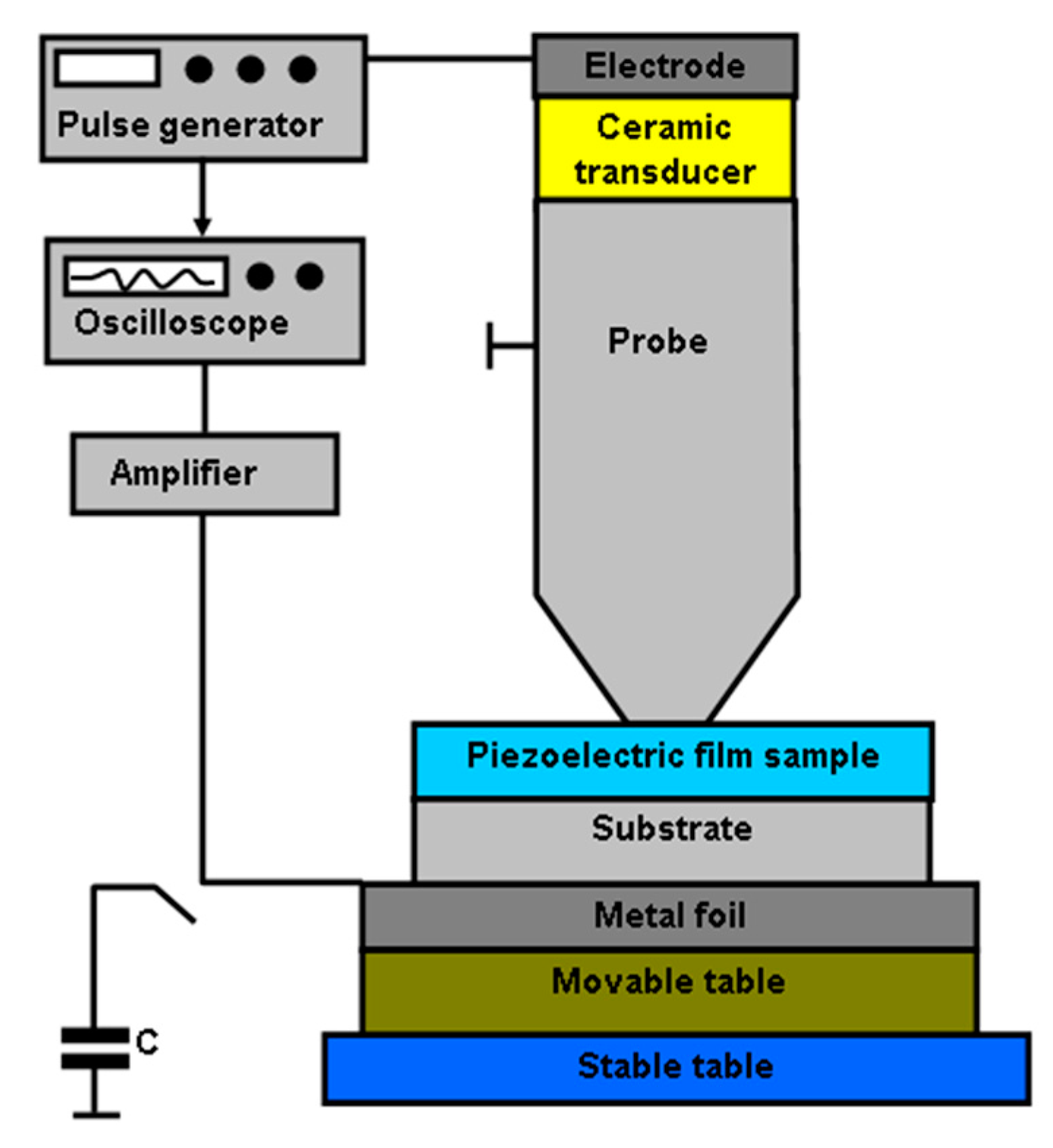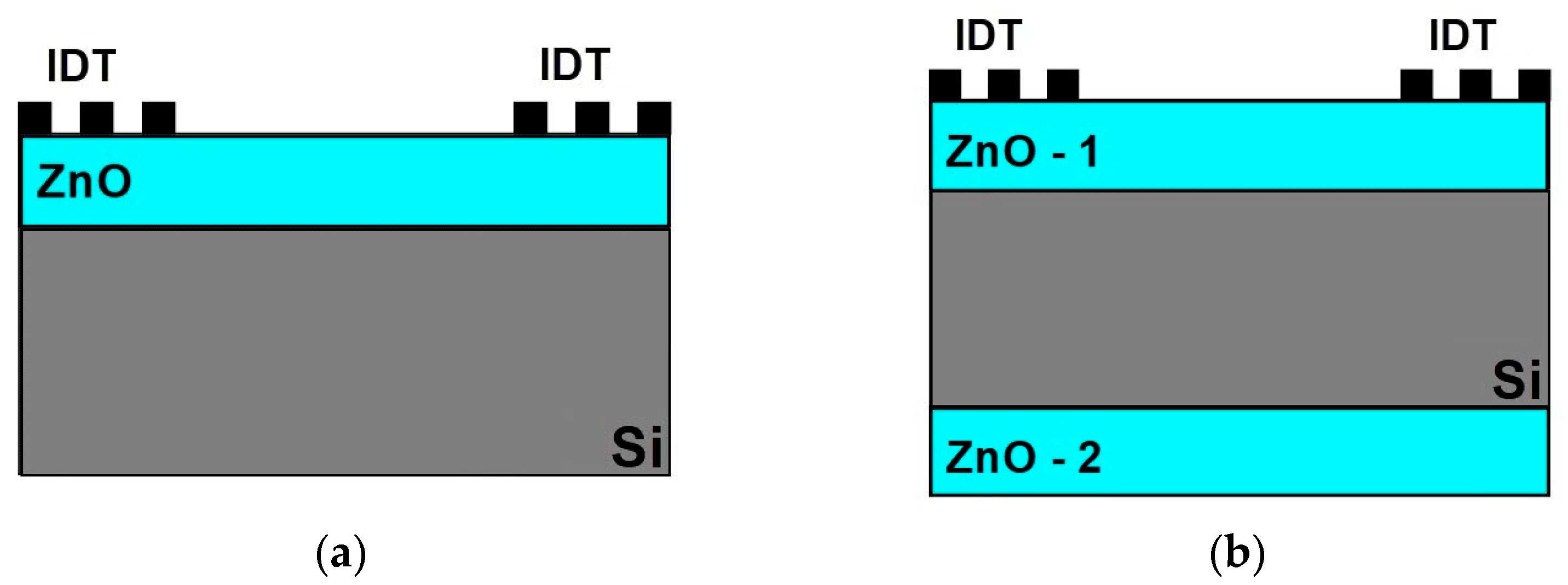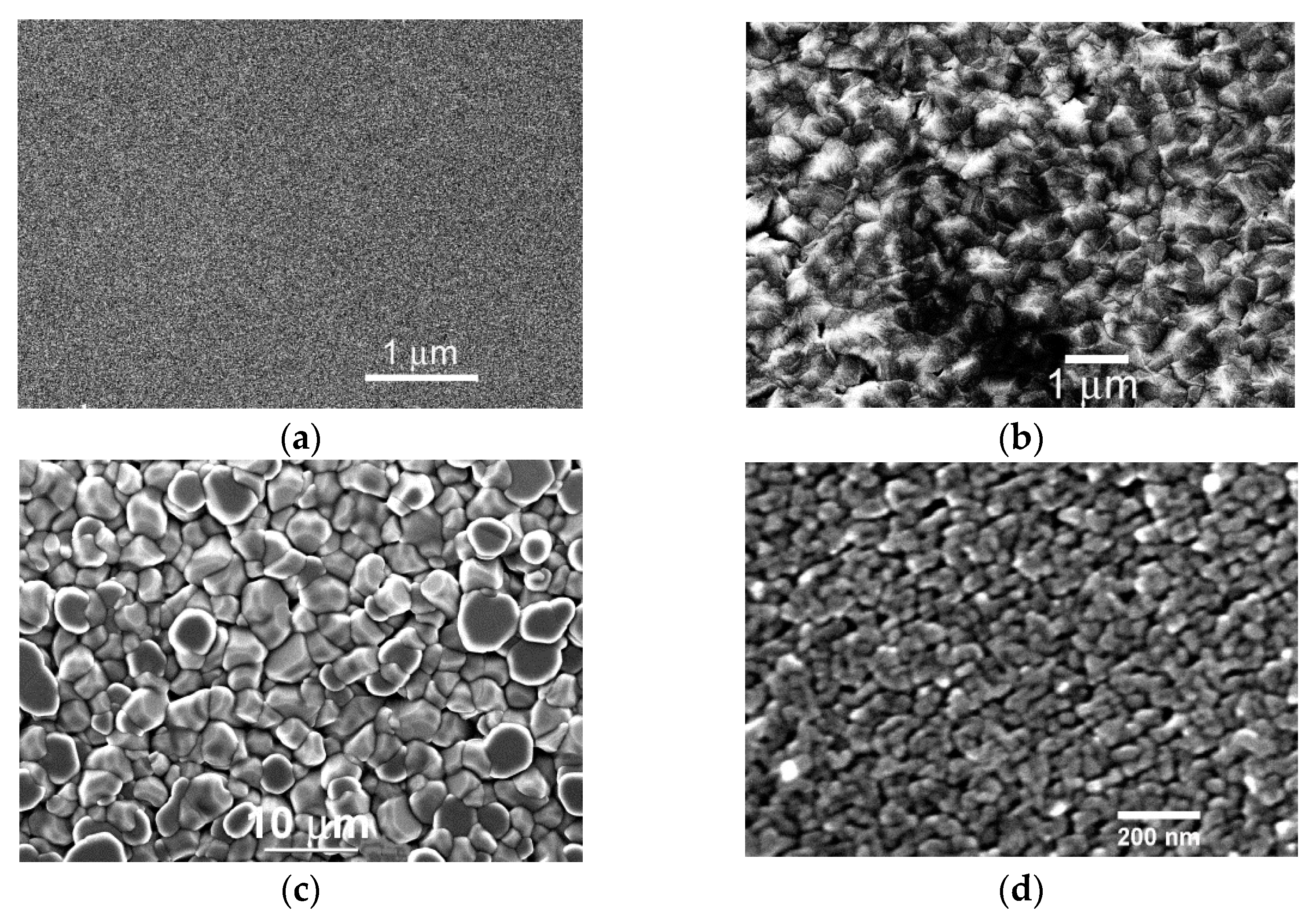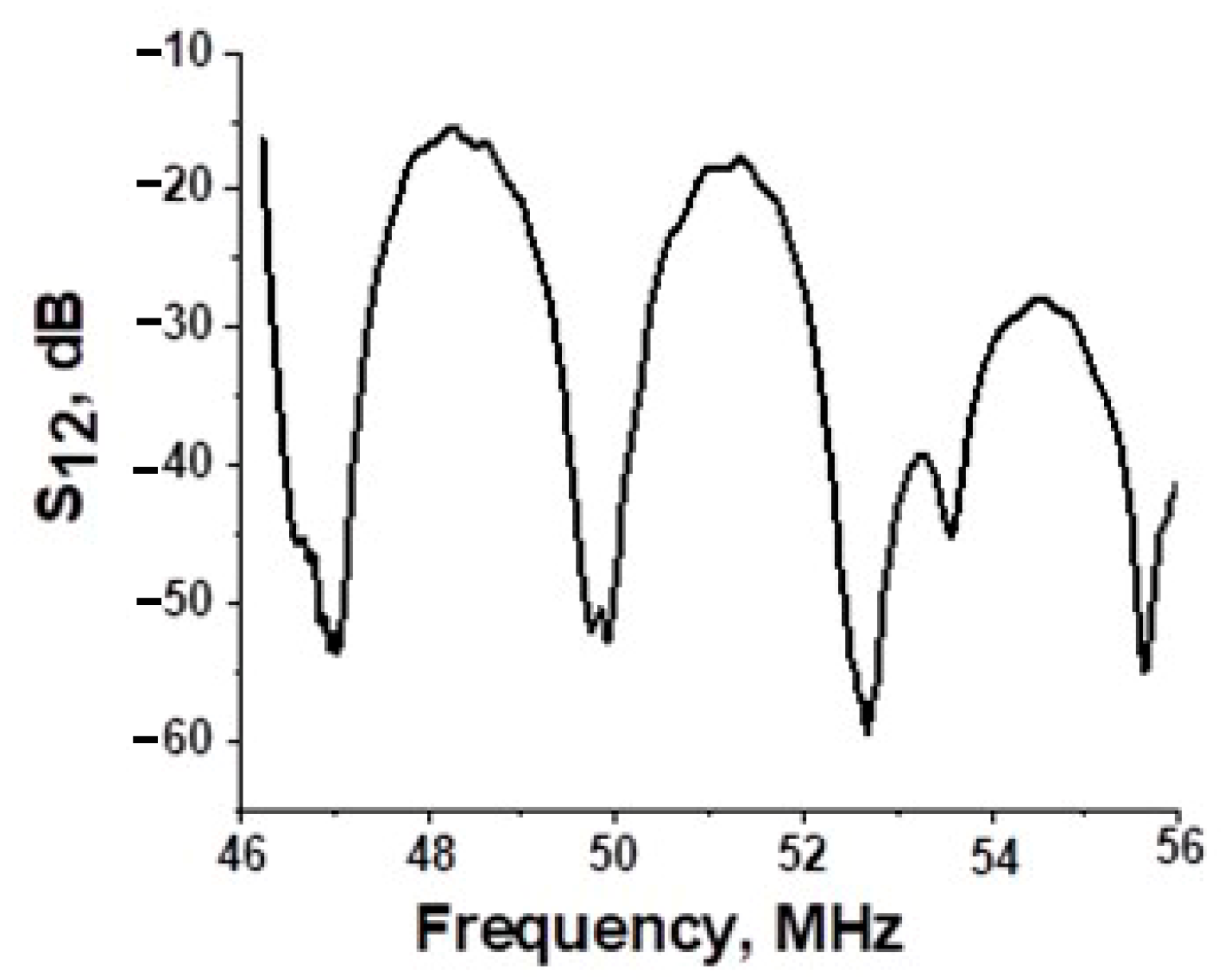ZnO Piezoelectric Films for Acoustoelectronic and Microenergetic Applications
Abstract
:1. Introduction
2. Materials and Methods
3. Results
3.1. ZnO Films Characterization Results
3.2. Modification of Piezoelectric ZnO Film Deposition
4. Discussion
5. Conclusions
Author Contributions
Funding
Data Availability Statement
Conflicts of Interest
References
- Vyas, S. A short review on properties and applications of zinc oxide based thin films and devices: ZnO as a promising material for applications in electronics, optoelectronics, biomedical and sensors. Johns. Matthey Technol. Rev. 2020, 64, 202–218. [Google Scholar] [CrossRef]
- Borysiewicz, M.A. ZnO as a functional material, a review. Crystals 2019, 9, 505. [Google Scholar] [CrossRef] [Green Version]
- Wu, Y.; Ma, Y.; Zheng, H.; Ramakrishna, S. Piezoelectric materials for flexible and wearable electronics: A review. Mater. Des. 2021, 211, 110164. [Google Scholar] [CrossRef]
- Anisimkin, V.I.; Voronova, N.V. Acoustic properties of the film/plate layered structure. IEEE Trans. Ultrason. Ferroelectr. Freq. Control. 2011, 58, 578–584. [Google Scholar] [CrossRef]
- Kuznetsova, I.E.; Anisimkin, V.I.; Kolesov, V.V.; Kashin, V.V.; Osipenko, V.A.; Gubin, S.P.; Tkachev, S.V.; Verona, E.; Sun, S.; Kuznetsova, A.S. Sezawa wave acoustic humidity sensor based on graphene oxide sensitive film with enhanced sensitivity. Sens. Actuators B Chem. 2018, 272, 236–242. [Google Scholar] [CrossRef]
- Li, Z.; Meng, X.; Wang, B.; Zhang, C. A three-dimensional finite element analysis model of SAW torque sensor with multilayer structure. Sensors 2022, 22, 2600. [Google Scholar] [CrossRef]
- Xu, H.; Fu, S.; Su, R.; Shen, J.; Zeng, F.; Song, C.; Pan, F. Enhanced coupling coefficient in dual-mode ZnO/SiC surface acoustic wave devices with partially etched piezoelectric layer. Appl. Sci. 2021, 11, 6383. [Google Scholar] [CrossRef]
- Li, L.; Miao, L.; Zhang, Z.; Pu, X.; Feng, Q.; Yanagisawa, K.; Fan, Y.; Fan, M.; Wen, P.; Hu, D. Recent progress in piezoelectric thin film fabrication: Via the solvothermal process. J. Mater. Chem. A 2019, 7, 16046–16067. [Google Scholar] [CrossRef]
- Lee, J.B.; Kim, H.J.; Kim, S.G.; Hwang, C.S.; Hong, S.H.; Shin, Y.H.; Lee, N.H. Deposition of ZnO thin films by magnetron sputtering for a film bulk acoustic resonator. Thin Solid Film. 2003, 435, 179–185. [Google Scholar] [CrossRef]
- Kim, T.H.; Park, J.J.; Nam, S.H.; Park, H.S.; Cheong, N.R.; Song, J.K.; Park, S.M. Fabrication of Mg-doped ZnO thin films by laser ablation of Zn:Mg target. Appl. Surf. Sci. 2009, 255, 5264–5266. [Google Scholar] [CrossRef]
- Tsay, C.-Y.; Fan, K.-S.; Chen, S.-H.; Tsai, C.-H. Preparation and characterization of ZnO transparent semiconductor thin films by sol-gel method. J. Alloys Compd. 2010, 495, 126–130. [Google Scholar] [CrossRef]
- Fragalà, M.E.; Malandrino, G.; Giangregorio, M.M.; Losurdo, M.; Bruno, G.; Lettieri, S.; Amato, L.S.; Maddalena, P. Structural, optical, and electrical characterization of ZnO and Al-doped ZnO thin films deposited by MOCVD. Chem. Vap. Depos. 2009, 15, 327–333. [Google Scholar] [CrossRef]
- Nam, G.; Leem, J.-Y. Fast-response photoconductive ultraviolet light detectors fabricated using high-quality ZnO films obtained by plasma-assisted molecular beam epitaxy. Ceram. Int. 2017, 43, 11981–11985. [Google Scholar] [CrossRef]
- Zinc Oxide Bulk, Thin Films and Nanostructures: Processing, Properties, and Applications; Jagadish, C.; Pearton, S.J. (Eds.) Scopus, Elsevier Science: Amsterdam, The Netherlands, 2006. [Google Scholar]
- Wang, Z.L. Nanostructures of zinc oxide. Mater. Today 2004, 7, 26–33. [Google Scholar] [CrossRef]
- Bhati, V.S.; Hojamberdiev, M.; Kumar, M. Enhanced sensing performance of ZnO nanostructures-based gas sensors: A review. Energy Rep. 2020, 6, 46–62. [Google Scholar] [CrossRef]
- Chaudhary, S.; Umar, A.; Bhasin, K.K.; Baskoutas, S. Chemical sensing applications of ZnO nanomaterials. Materials 2018, 11, 287. [Google Scholar] [CrossRef] [Green Version]
- Elhosni, M.; Elmazria, O.; Petit-Watelot, S.; Bouvot, L.; Zhgoon, S.; Talbi, A.; Hehn, M.; Aissa, K.A.; Hage-Ali, S.; Lacour, D.; et al. Magnetic field SAW sensors based on magnetostrictive-piezoelectric layered structures: FEM modeling and experimental validation. Sens. Actuators A-Phys. 2016, 240, 41–49. [Google Scholar] [CrossRef] [Green Version]
- Shetti, N.P.; Bukkitgar, S.D.; Reddy, K.R.; Reddy, C.V.; Aminabhavi, T.M. ZnO-based nanostructured electrodes for electrochemical sensors and biosensors in biomedical applications. Biosens. Bioelectron. 2019, 141, 111417. [Google Scholar] [CrossRef]
- Theerthagiri, J.; Salla, S.; Senthil, R.A.; Nithyadharseny, P.; Madankumar, A.; Arunachalam, P.; Maiyalagan, T.; Kim, H.-S. A review on ZnO nanostructured materials: Energy, environmental and biological applications. Nanotechnology 2019, 30, 392001. [Google Scholar] [CrossRef]
- Savarimuthu, K.; Sankararajan, R.; Govindaraj, R.; Narendhiran, S. A comparative study on a flexible ZnO-based nano-generator using Schottky and p-n junction contact for energy harvesting applications. Nanoscale 2018, 10, 16022–16029. [Google Scholar] [CrossRef]
- Singh, H.H.; Khare, N. Flexible ZnO-PVDF/PTFE based piezo-tribo hybrid nanogenerator. Nano Energy 2018, 51, 216–222. [Google Scholar] [CrossRef]
- Dunn, S. Micropower: The next electrical era. Worldwatch Pap. 2000, 151, X-94. [Google Scholar]
- Yang, Z.; Zhou, S.; Zu, J.; Inman, D. High-performance piezoelectric energy harvesters and their applications. Joule 2018, 2, 642–697. [Google Scholar] [CrossRef] [Green Version]
- Joshi, S.; Nayak, M.M.; Rajanna, K. Evaluation of transverse piezoelectric coefficient of ZnO thin films deposited on different flexible substrates: A comparative study on the vibration sensing performance. ACS Appl. Mater. Interfaces 2014, 6, 7108–7116. [Google Scholar] [CrossRef]
- Zhao, X.; Huang, D.; Li, G.; He, Y.; Peng, W.; Li, G. High sensitivity X-ray detector based on a 25 µm-thick ZnO film. Sens. Actuators A Phys. 2022, 334, 113310. [Google Scholar] [CrossRef]
- Slobodnik, A.J. The temperature coefficients of acoustic surface wave velocity and delay on lithium niobate, lithium tantalate, quartz, and tellurium dioxide. Phys. Sci. Res. 1972, 1, 477. [Google Scholar]
- Tomar, M.; Gupta, V.; Sreenivas, K.; Mansingh, A. Temperature stability of ZnO thin film SAW device on fused quartz. IEEE Trans. Device Mater. Reliab. 2005, 5, 494–500. [Google Scholar] [CrossRef]
- Carlson, E.J.; Strunz, K.; Otis, B.P. A 20 mV input boost converter with efficient digital control for thermoelectric energy harvesting. IEEE J. Solid-State Circuits 2010, 45, 741–750. [Google Scholar] [CrossRef]










Publisher’s Note: MDPI stays neutral with regard to jurisdictional claims in published maps and institutional affiliations. |
© 2022 by the authors. Licensee MDPI, Basel, Switzerland. This article is an open access article distributed under the terms and conditions of the Creative Commons Attribution (CC BY) license (https://creativecommons.org/licenses/by/4.0/).
Share and Cite
Golovanov, E.; Kolesov, V.; Anisimkin, V.; Osipenko, V.; Kuznetsova, I. ZnO Piezoelectric Films for Acoustoelectronic and Microenergetic Applications. Coatings 2022, 12, 709. https://doi.org/10.3390/coatings12050709
Golovanov E, Kolesov V, Anisimkin V, Osipenko V, Kuznetsova I. ZnO Piezoelectric Films for Acoustoelectronic and Microenergetic Applications. Coatings. 2022; 12(5):709. https://doi.org/10.3390/coatings12050709
Chicago/Turabian StyleGolovanov, Egor, Vladimir Kolesov, Vladimir Anisimkin, Victor Osipenko, and Iren Kuznetsova. 2022. "ZnO Piezoelectric Films for Acoustoelectronic and Microenergetic Applications" Coatings 12, no. 5: 709. https://doi.org/10.3390/coatings12050709
APA StyleGolovanov, E., Kolesov, V., Anisimkin, V., Osipenko, V., & Kuznetsova, I. (2022). ZnO Piezoelectric Films for Acoustoelectronic and Microenergetic Applications. Coatings, 12(5), 709. https://doi.org/10.3390/coatings12050709







